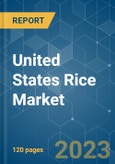Key Highlights
- In the United States, areas under rice cultivation increased rapidly over time due to increased long-grain rice production. The grain types grown across the United States include long, medium, and short grain. However, long-grain types and hybrids are more common in southern states, whereas medium-grain types are more common in California.The major rice-producing areas include Arkansas, Mississippi, Missouri, Texas, California, and Louisiana, accounting for 1.17 hectares of land under rice cultivation.
- The US rice industry has made impressive progress. The US rice industry has improved land use efficiency by 39%, reduced soil erosion by 28%, and decreased water use by 52%. It has also reduced energy use by 34% while cutting greenhouse gas emissions by 41%. And as part of its commitment to continuous improvement, it has set ambitious targets for 2030 to maintain and improve it for the next generation.
- Meanwhile, US farmers were looking for crops with promises of larger margins. They reported to the United States Department of Agriculture (USDA) that they intended to plant 3% fewer rice acres in 2022 than in 2021. Except there was one problem. Most of the surveys were completed before the impacts of Russia's invasion of Ukraine were realized. They were also carried out before California, the second-largest rice-producing state, had completed 2022 water allocations - affecting United States' food supply. However, the US legislators established a fair farm safety net to assist farmers during their most difficult years of production, which will support the market over the coming years.
- The factors driving the market demand are government support in the production of rice, growing demand for rice for numerous uses, an increasing number of rice processing companies, and rising exports to regions like Mexico, Northeast Asia, Central America, the Caribbean, Canada, the Middle East, the European Union, and Sub-Saharan Africa. These factors will boost the growth of the market during the forecasting period.
United States Rice Market Trends
Steady Increase in Production is Driving the Market
- Rice production in the United States is increasing steadily due to an increase in acreage under rice cultivation. The country normally specializes in a specific type of rice, referred to in the United States by the length of grain - long, medium, and short. US long-grain varieties are dry and separate, while US medium and short-grain varieties are moist, clingy, or sticky.
- In general, long-grain production accounts for around 75% of the US rice production, medium-grain production for about 24%, and short-grain for the remainder. Due to the pandemic, the United States produced 191.8 million hundredweight (cwt) of rough rice in 2021, a 16% decrease from the crop in 2020 but still significantly higher than in 2019.
- US long-grain rice production is concentrated in the South. Arkansas typically grows 56-58% of the US long-grain crop. California typically grows 70-76% of the crop, making it the primary producer of medium-grain rice. Although California is experiencing a drought, Arkansas produces a significant amount of medium grain, which sustains the rice market's growth.
- According to Food and Agriculture Organization (FAO), rice production in the United States was 10.3 million metric tons in 2020, which has declined to 8.6 million metric tons in 2021 due to the pandemic impact on the country. However, increasing production is due to increased acreage under rice cultivation, which accounts for 1.17 million hectares compared to 0.96 million hectares last year. Further, the constant increase in acreage under rice cultivation in the United States will boost productivity, which will drive the United States rice market during the forecast period.
The United States Acts as the Major Exporter
- The United States is a consistent, timely supplier of high-quality rice in both the long- and combined medium- and short-grain global markets and accounts for less than 2% of global rice production. It ships almost 5% of global exports and is currently the fifth-largest exporter. Exports are thus important to the US rice industry, with around 45% of the crop currently exported each year.
- The United States rice is majorly shipped to more than 120 countries worldwide every year, making the United States the fifth largest exporter. And while US production is typically around 3 million acres, which tends to oscillate depending on several economic, weather, and regulatory factors. According to ITC Trade, the export value of rice in the country increased in 2022 compared to last year (USD 1.9 million in 2021), further encouraging the market to grow in the future.
- The major exporting partners for the US within the region are Mexico, Canada, and Haiti. The country exports rough rice, parboiled rice, brown rice, and fully milled rice. The regular imports of rice account for nearly 10% of the US food use of rice. According to International Trade Center (ITC) Trade, the quantity of rice exported from the United States amounted to 3.3 million metric tons in 2021, a slight increase compared to the previous year, with 3.2 million metric tons in 2020. Increasing the export of rice year over year will boost the United States rice market during the forecast period.
United States Rice Industry Overview
Additional Benefits:
- The market estimate (ME) sheet in Excel format
- 3 months of analyst support
This product will be delivered within 2 business days.










